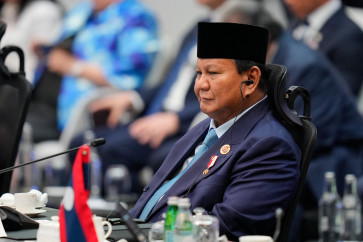Popular Reads
Top Results
Can't find what you're looking for?
View all search resultsPopular Reads
Top Results
Can't find what you're looking for?
View all search results'Ariah' radiates the spirit of Betawi
The National Monument (Monas) serves as an impressive backdrop for the musical, Ariah
Change text size
Gift Premium Articles
to Anyone
The National Monument (Monas) serves as an impressive backdrop for the musical, Ariah.
Through its spectacular blaze and glaze, the dance musical, Ariah, delivered an energizing artistic performance for the seemingly hopeless and hapless citizens of Jakarta.
The colossal musical, performed on a massive stage at the National Monument (Monas) compound in Central Jakarta, stayed true to its purpose of marking Jakarta's 486th anniversary.
Ariah is based on a Betawi (native Jakarta) legend of an emancipated woman who was also a significant figure in the Tambun farmers' rebellion against Dutch rule in 1869, when Jakarta was still known as Batavia.
The historical Ariah is said to have been a poor girl who fell victim to abuse and died while defending herself in Ancol.
Another version of the folktale, a popular one which tells the story of Mariah or Mariam, diminishes the character into a mythical ghost at Ancol Beach, which was later picked up as the plot for a television horror comedy series in the 1990s.
As one of the highlights of the Jakarta anniversary's month-long celebration, the dance musical, which is performed until Sunday, showcased a variety of Betawi traditional arts, namely, music, dance, martial arts, theater and comedy.
Ariah radiates energy with all its 200 dancers gracing the stage and moving to dynamic music played by the 100-strong orchestra, under the direction of Erwin Gutawa.
The cornucopia of Betawi arts was presented to the audience on a very contemporary and modern plate, mixed with orchestra ensemble, lighting techniques, stage special effects, video mapping, fireworks and extravagant stage design.
Ariah begins with the eponymous heroine (played by Ida Sunaryono) realizing the historical framework in which she and her people are living. Tension is rising as poor farmers in Tambun protest against oppression by the colonial government and landlords.
With her mother, Mak Emper (Yuyun Arfah), and sister Mpok (Conni Retno Kusumawati), Ariah lives on the outskirts of a large plot of land owned by Tuan Mandor (Iyoq Kusdini).
Enlightened by the situation, the coming-of-age Ariah encourages her friends to educate themselves through silat (traditional martial arts) and religion.
Ariah then falls for her silat master, Juki (Fajar Satriadi), who saves her and her friends from Tuan Mandor's thugs.
Ariah continues growing into a beautiful young woman and quickly attracts attention from Tuan Mandor and womanizing wealthy trader Oey Tambah Siang (Anggiyatma P. Messofanti).
The musical blends a range of Betawi traditional arts, from music, dance, martial arts and theater to comedy.
Tuan Mandor demands Mak Emper surrender Ariah to be one of his wives through his henchmen, Piun (Atien Kisam) and Sura (Djarot Budidarsono).
When a riot erupts in Tambun, Ariah leads her friends to help the oppressed farmers. On her way home, she is stopped by Piun and Sura, who intend to kidnap her at the behest of Tuan Mandor.
Ariah is the second production by director and scriptwriter Atilah Soeryadjaya, who won praise for her first work Matah Ati, an epic contemporary Javanese play.
In Ariah, Atilah collaborated again with her Matah Ati team, which included artistic and stage director Jay Subyakto, assistant director Fajar Satriadi, stage manager Inet Leimena and choreographers Daryono S. Kar and Eko Supendi.
Like Matah Ati, Ariah presented an innovative stage design, Jay's brainchild.
Matah Ati was performed on a sloping metal stage, Ariah boasted a massive 72-meter wide stage, comprising three different levels at the heights of 3, 7 and 10 meters.
Ariah is the second production by director and playwright Atilah Soeryadjaya, who previously won praise for her epic contemporary Javanese play, Matah Ati.
The lower two levels had their own steep reclining parts ' sloping between 15 and 35 degrees ' on the sides and a three-sided pyramid in the middle.
Blazing life onto the stage were three massive lighting and video projectors ' two of which stood either side of the stage, around 20 meters high. The video projection also used almost two-thirds of the 132-meter Monas obelisk as a screen.
In full throttle, Ariah radiated with energy when all of its 200 dancers graced the stage basking in animated lighting, moving to the dynamic music played by the 100-strong orchestra under the direction of Erwin Gutawa.
The gigantic stage, however, made it hard to pinpoint which actor was singing or playing the main part of a scene, but zoomed-in camera images on screens on both sides of the stage helped the audience follow the performance.
The crushing conditions of Ariah's life and her struggle are a theme Jakartans are very much familiar with. Ariah's cast, especially Yuyun and Ida, managed to make the story resonates with the audience.
With flowing command of Ariah's majestic movements, effects, lights and sounds, Atilah, Jay, Erwin and their team showed they are master wizards of stagecraft.
' Photos by P.J. Leo














